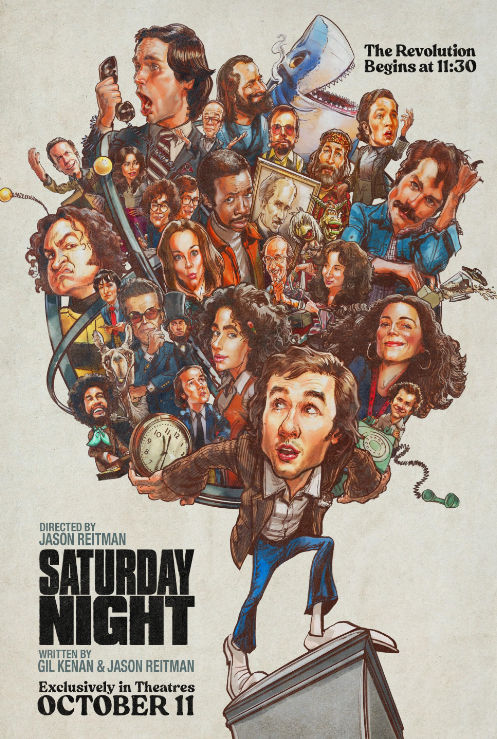“Saturday Night Live” premiered as a show consisting of comedy sketches performed by a cast of celebrities on Oct. 11, 1975. On the 49th anniversary of the first episode, a biopic titled “Saturday Night” was released about the cast of the show’s first opening night.
With a Rotten Tomatoes critic’s score of 81% and an IMDb rating of 7.4/10, the film follows the show’s original cast and crew preparing for the show’s first episode. Viewers learn about the cast’s personality, goals and relationships as they speculate whether their show will be a success or a failure.
The film’s protagonist is Lorne Michaels, creator of “Saturday Night Live,” who is played by Gabriel LaBelle. The film follows Michaels as he fights against the doubts of studio executives to protect his vision and get his show to air.
Luckily, the film primarily focuses on the members of the cast and merely uses Michaels as a conduit to understand their behavior, as Michaels’ character isn’t talented or funny like his costars.
Considering that the actors must try to be as funny as the real-life cast of venerable comedians, the standard is set quite high. Fortunately, the film’s performances are absolutely hilarious. The great thing about watching comedians argue is that they have a hilarious comeback to everything, and the film captures that dynamic well, resulting in almost every conversation being funny — even during the most serious points in the plot.
This pacing stands out from most movies, as it happens in real time; matching the length of an episode of “Saturday Night Live,” the movie is 90 minutes long. Multiple times throughout, the screen goes dark and marks the end of a minute by showing the clock ticking to the next, simulating the stress that the cast is under. This makes the film incredibly immersive, and the audience may feel as if it is in the room with the cast as they joke, argue and scramble for time.
The film’s cinematography is impressive, as it effectively mythologizes the cast of influential comedians by keeping the most important characters off-screen for much of the film, building anticipation for the eventual introduction of the cast. This technique is often used in film to create suspense and grandeur around a character.
The film places one character’s importance above all: John Belushi.
Played by Matt Wood in the movie, Belushi was a member of the show’s original cast and is widely revered for his talent and influence in the world of comedy. Because of the large shadow he has cast in the industry, the film carefully conserves his screen time to ensure that when he is on screen, all eyes are fixed on him. He is first shown through a monitor, immortalizing him on screen.
Wood portrays Belushi perfectly, mastering his mannerisms and vocal patterns. When combined with the striking resemblance between the actor and his role, one may forget they’re not watching the real Belushi in action.
Contrasting Belushi’s reclusive personality is Chevy Chase, played by Cory Michael Smith. Chase is a fellow cast member who repeatedly makes fun of Belushi’s physical appearance,breaking from his co-stars, who only speak fondly of Belushi. The tense dynamic between the two establishes an encaptivating contrast between Chase and Belushi early on in the film, and the actors portraying the characters give the most impressive performances in the film.
While the film’s conflict may be engaging, it may require prior knowledge about the characters to enjoy the film at all. For example, the reason why Belushi is talked about by the cast as if he is a mythological creature is because of the mark he has made since the year the movie took place, and those who don’t know Belushi might not view him with such importance.
Additionally, the film uses his depression and drug use to foreshadow the fact that he will die at 33 from a drug overdose, making his character’s struggles in the film far more tragic to watch for those who know how Belushi’s life was cut short in real life.
Overall, the film’s attention to detail and effective character development make it a must-watch for fans of comedy and its history. While the niche references and foreshadowing may exclude unfamiliar moviegoers, its intended audience is brought 90 minutes of remarkable cinema.









